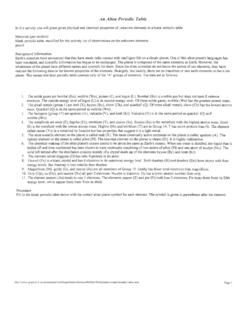Transcription of Hunting for Huntington’s Evidence: An Empirical ...
1 Hunting for Huntington s evidence : An Empirical reassessment of The clash of Civilizations Theory John Daniel Shindelar Department of Political Science bemidji State university I inquire into Samuel P. Huntington s clash of civilizations theory as outlined in his landmark The clash of Civilizations. I explore conflicts starting at the end of the Cold War to 2007 in order to examine whether Huntington s theory has been materializing (there is a marked increase in conflicts between Civilizations and they have become more intense) or if the face of conflicts has stayed relatively similar to Cold War era clashes. I use International Crisis Behavior data on conflicts since the fall of the which Huntington cites as the end of a bipolar world and the beginning of a new era of conflicts.
2 I show that there is not a marked increase in the clash of civilizations that Huntington predicted. Faculty Sponsor/Editor: Dr. Patrick Donnay INTRODUCTION Whether you are analyzing the present world or looking into the history of the world s civilizations, conflict has always been a major player in world change. Conflict Theory is an important aspect of foreign policy and international relations. Opinions towards the matter cover a broad range of beliefs, and much controversy surrounds this topic. Conflict has often been the catalyst for inventing and implementing new technologies, a push for better efficiency, better resource management, uniting people in groups against a common enemy, and prompting new medical discoveries as doctors strive to find the best way to treat injured and wounded soldiers.
3 However conflict often devastates families, neighborhoods, nations and economies through direct harm, refugees, disease, rape, and the strain required to maintain the fight or carry out war. Determining why a certain crisis arises can be challenging due to the major accumulation of grievances a conflict can involve. This is further complicated when considering that conflict may be in the process of changing or may have already changed. As stated by President Ronald Reagan, Peace is not absence of conflict; it is the ability to handle conflict by peaceful means. It is therefore our responsibility as citizens to explore the possibilities and determine what can be done to prevent conflict and crisis from arising as best we can.
4 It is recognizable that not all crises can be averted; however, it is our duty in those situations to work on understanding how best to reconcile and attain peace. Conflict Theory is a highly debated topic and much research is done to understand it and how it has developed. Several scholars have done quantitative research of the clash of civilizations theory. However, their research is limited in the scope of data they used while others used incorrect approaches on how to operationalize and test the theory. I explore whether or not there is Empirical evidence for Samuel Huntington s clash of civilizations theory. Previous studies used the Correlate of War (COW), Militarized Interstate Disputes (MID), State Failure, Minorities at Risk (MAR), and Kosimo datasets.
5 I use a new dataset, the International Crisis Behavior project dataset, for my analysis. This dataset has not formerly been used in assessing Huntington s theory. This dataset covers more years in the post-Cold-War era than previous studies, almost doubling the longest study by Chiozza (2002) by adding 10 years. LITERATURE REVIEW The Theory of clash of Civilizations The Next Pattern of Conflict Many intellectuals over the past two decades have speculated how the end of the Cold War has changed global politics. Many have pondered at what new systems are coming to light. There is much controversy over how to explain how the world functions in a global political sense at its most basic functions.
6 Many scholars are questioning the importance of nation states and their influence. In the late 1980 s and early 1990 s Samuel Huntington started looking for new ways for explaining the reasons for conflict. He called his concept the clash of civilizations . Huntington theorized that the main source of conflict in the new world order would not be primarily ideological or primarily economic. Instead Huntington puts forth the idea that the dominating source of conflict will be cultural. He concedes that nation states will still remain the most powerful actors in world affairs, but that conflicts concerning global politics will primarily be due to civilizational difference.
7 Huntington theorized that nation- states were fading in influence and argued that nation- states are no longer reflective of actual borders. Huntington divides the world into eight civilizational groupings: Western, Confucian, Japanese, Islamic, Hindu, Slavic-Orthodox, Latin American, and possibly Africa . (The clash of Civilizations, Huntington, 1993) Huntington includes Africa because although there is a lack of solidarity among the African nations they do have common cultural ties. The possible African civilization does not have a core state to lead them and bind them together, and there is a more diverse culture base. These civilizations may seem like just another sociological way in which to categorize people but Huntington says, Civilizations are nonetheless meaningful entities, and while the lines between them are seldom sharp, they are real.
8 (Huntington, 1993, p. 24) Civilizations Conflict has in the past several centuries taken place between multiple nation-state entities which Huntington tries to explain with civilizations. Civilizational commonality is a way of grouping together nations with common cultural identities; this includes ethnicity, religion, history, and values, and economics. Huntington argues that basic cultural backgrounds bind people together beyond what any nation-state can hope to achieve. Huntington points out that you cannot change your ethnicity. And although you can be born half-French and half-Arab and be a citizen of two countries, you cannot be half-Catholic and half-Muslim.
9 Religion is another key discriminator because there is no middle ground. A people s history, although you may change the way you look at it or write it, is also a binding factor among peoples. Your values mostly stem from religion, history, or ethnicity or from any combination of the three. Huntington also pointed out that economic regionalism is increasingly leading to more consciousness of civilizational identity. People naturally think like mindedly within their civilization and have much more in common than they would with people from another civilization . People having a common cultural background, way of thinking, and a similar worldview will have stronger loyalty to one another than people just brought together in a nation-state by lines drawn on a map.
10 These differences are products of centuries. They will not soon disappear . (Huntington, 1993, p. 25) Huntington s breaks the world down into eight different civilizations according to these parameters. The Confucian civilization is the common culture of China and Chinese groups that have migrated and spread throughout Southeast Asia. This includes areas such as Vietnam, North and South Korea as well as Taiwan, Singapore, Hong Kong, Hainan, and the Manila region of the Philippines. Figure 1. Map distinguishing the different civilizations across the world within Huntington s clash of Japanese civilization is unique in that Huntington says it only encompasses Japan and its islands.














